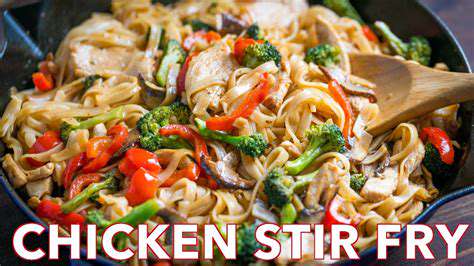Simple Chicken Stir Fry: Quick and Healthy
Stir-Frying the Vegetables
Choosing Your Vegetables
Picking the right veggies for your stir-fry can make or break the dish. Go for a rainbow of colors and crunchy textures to keep things interesting. Vibrant bell peppers and carrots aren't just pretty - they pack a flavor punch too. Leafy greens like spinach or bok choy bring freshness to the mix. Always trust your taste buds - if you love certain vegetables, they'll probably work great in your stir-fry.
Freshness is non-negotiable. Crisp vegetables mean better texture and taste in your final dish. Limp, old veggies? They'll drag down your whole meal. Wash and chop everything beforehand - it makes cooking smoother and your stir-fry will look restaurant-worthy. A thorough rinse gets rid of any grit, making your meal safer to eat.
Stir-Fry Technique for Perfection
This cooking method needs speed and high heat. Your wok or skillet should be smoking hot before anything touches it. Why? That intense heat locks in nutrients and creates that delicious sear we all love. Mastering the heat is 90% of the stir-fry battle - get it right and your ingredients will sing.
The constant motion separates amateurs from pros. Whether you use chopsticks or a spatula, keep everything moving. This even cooking prevents burning and ensures every bite is perfectly sauced. Timing is everything - know when to add each ingredient so nothing ends up mushy or raw.
Seasoning and Sauce Considerations
Seasoning transforms good into great. Basic salt and pepper work, but why stop there? Ginger and garlic can take your dish to new heights. The right seasoning makes vegetables shine without overpowering them. Taste as you go - your palate knows best.
Sauces are where personality comes through. Soy sauce is classic, but honey adds sweetness, oyster sauce brings depth. The perfect sauce complements without drowning the ingredients. Experiment until you find your signature blend - that's where the magic happens.
Cooking the Chicken and Finishing the Stir-Fry

Choosing the Right Chicken
Not all chicken is created equal for stir-fries. Thighs beat breasts here - they stay juicy when cooked fast at high heat. The right cut makes all the difference between dry disappointment and succulent success. Look for plump, pink flesh with no odd smells - that's your freshness guarantee.
Preparing the Chicken
Prep work separates the okay cooks from the great ones. Trim excess fat (it won't render fast enough in stir-frying), but leave some for flavor. Marinate briefly - even 15 minutes makes a difference. And please - no hot water rinses! That just spreads bacteria around your kitchen.
Brining the Chicken (Optional)
Got time to spare? Brining works wonders. That salty soak keeps chicken moist through the high-heat cooking. It's like insurance against dryness - especially helpful if you're using breast meat.
Cooking Methods for Chicken
Stir-frying chicken needs attention. Cut uniform pieces, cook in batches if needed, and never crowd the pan - that leads to steaming instead of searing. Watch for that perfect golden color - it's your visual doneness cue.
Complementary Ingredients
Chicken plays well with others. Think about textures and flavors that contrast or complement. Crunchy water chestnuts? Velvety mushrooms? The supporting cast can steal the show if chosen wisely.
Finishing Touches and Serving
First impressions matter. A sprinkle of sesame seeds, some green onion confetti - these final flourishes make people excited to eat. Serve immediately while everything's hot and crisp.
Safety Considerations
Thermometers aren't optional - 165°F (74°C) means safe chicken. No guessing games with poultry. And handle cooked chicken like the perishable food it is - proper storage prevents unhappy stomachs later.

- Exploring Italian Pasta Dishes: Beyond Spaghetti Bolognese
- Quick Weeknight Meals: From Pantry to Plate
- Pantry Organization Hacks: Declutter Your Kitchen
- Pantry Staples for Healthy Eating: Must Have Ingredients
- Speedy Weeknight Dinners: 15 Minute Chicken Stir Fry
- Quick & Easy Sheet Pan Salmon: Healthy and Fast
- Vegan Lunch Ideas for Work: Easy and Convenient
- Quick & Easy Breakfast Muffins: On the Go Options
- Authentic Brazilian BBQ: Churrasco Techniques
- Healthy Breakfast Bowls: Customizable and Nutritious
- Understanding Probiotics: Benefits and Food Sources
- Preventing Food Waste: Creative Ways to Use Up Leftovers